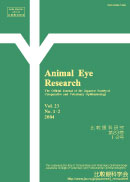Volume 23, Issue 1-2
Displaying 1-3 of 3 articles from this issue
- |<
- <
- 1
- >
- >|
Review
-
Article type: Review
2004 Volume 23 Issue 1-2 Pages 1-2_3-1-2_13
Published: June 30, 2004
Released on J-STAGE: March 28, 2015
Download PDF (736K)
Brief Note
-
Article type: Brief Note
2004 Volume 23 Issue 1-2 Pages 1-2_15-1-2_17
Published: June 30, 2004
Released on J-STAGE: March 28, 2015
Download PDF (597K)
Brief Note
-
Article type: Brief Note
2004 Volume 23 Issue 1-2 Pages 1-2_19-1-2_21
Published: June 30, 2004
Released on J-STAGE: March 28, 2015
Download PDF (556K)
- |<
- <
- 1
- >
- >|
